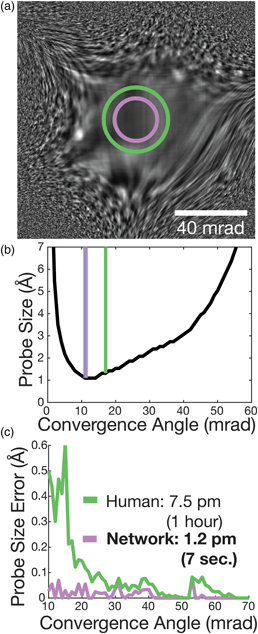Published online by Cambridge University Press: 06 August 2020

The selection of the correct convergence angle is essential for achieving the highest resolution imaging in scanning transmission electron microscopy (STEM). The use of poor heuristics, such as Rayleigh's quarter-phase rule, to assess probe quality and uncertainties in the measurement of the aberration function results in the incorrect selection of convergence angles and lower resolution. Here, we show that the Strehl ratio provides an accurate and efficient way to calculate criteria for evaluating the probe size for STEM. A convolutional neural network trained on the Strehl ratio is shown to outperform experienced microscopists at selecting a convergence angle from a single electron Ronchigram using simulated datasets. Generating tens of thousands of simulated Ronchigram examples, the network is trained to select convergence angles yielding probes on average 85% nearer to optimal size at millisecond speeds (0.02% of human assessment time). Qualitative assessment on experimental Ronchigrams with intentionally introduced aberrations suggests that trends in the optimal convergence angle size are well modeled but high accuracy requires a high number of training datasets. This near-immediate assessment of Ronchigrams using the Strehl ratio and machine learning highlights a viable path toward the rapid, automated alignment of aberration-corrected electron microscopes.